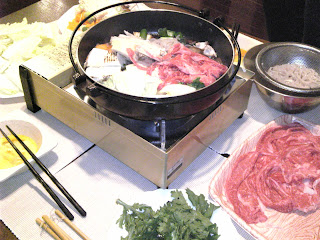
Back when I was a young man there was a hit song: “Sukiyaki,” sung in Japanese by a crooner named Kyu Sakamoto. As far as I know it was the only Japanese language song to top the charts in the U.S. It wasn’t until years later when I was in Japan that I discovered the dish, sukiyaki. This gem is a popular one-pot meal in Japan, and is the perfect winter dish. It is a dish cooked in the nabemono (Japanese Hot Pot) style; and normally consists of thin slices of beef slowly cooked or simmered in a pan or skillet with other ingredients such as vegetables, to which soy sauce, sugar and mirin (Japanese rice wine) can be added. A vegetarian version can be made with tofu.
The origins of sukiyaki are murky. Meat, especially game and poultry has been cooked in Japan since time immemorial. Farmers use to cook the meat (yaki) by grilling it outside on a spade or plow share (suki). Hence, the literal meaning, sukiyaki. In the 16th century Portuguese traders brought beef with them, and the Japanese started preparing sukiyaki with beef.
Today sukiyaki is popular world-wide, and can be found in many restaurant menus. It is the perfect party dish since it can be cooked at table with the ingredients already set individually or in a large plate. You cook the ingredients as you go. You don’t have to cook in the kitchen, as noted in the recipe below. And remember that sukiyaki is a communal thing. It cannot wait for the guests. Before cooking begins, have your guests comfortable and seated, nibbling on appetizers, and the hot rice served at the beginning.
SUKIYAKI
1 1/2 pounds beef tenderloin or flank steak
1 pound rice (it could be short grain, such as Nishiki, or medium or long grain)
1/2 pound transparent or silver noodles
6 scallions, washed and cut into thin slices (minus the root end)
8-10 white mushrooms, cut through the stem and crown so that it resembles a “T” shape.
1/2 pound fresh spinach, washed and torn into bite-size pieces
1 pound canned bamboo shoots, drained
1/2 pound bean sprouts, drained if canned. If fresh, blanch, then rinse and drain.
2 tablespoons peanut oil
Sauce:
1 cup soy sauce
1/2 cup rice wine (mirin) or dry sherry
2 teaspoons sugar
1. Put the meat in the freezer for about 1/2 hour to firm it enough so that it can be sliced into paper thin slices. If the slices are longer than 4 inches, halve them. Arrange meat slices on a round platter, slightly overlapping, cover with aluminum foil and refrigerate.
2. Cook rice according to package directions. Set aside and keep it warm.
3. Place noodles in a bowl. Cover with boiling water, and soak for 20 minutes. Drain, and repeat procedure. Drain again and place in bowl.
4. Here you have a choice. You can either arrange all the vegetable on a large platter. Or you can put the onions and scallions in one bowl, each divided into one-half of the bowl; and the mushrooms, spinach, bamboo shoots, and bean sprouts into their own small bowls as well.
5. Prepare sauce: In a small saucepan bring soy sauce, rice wine or sherry, and sugar to a boil. Pour into a sauce dish.
6. Place wok (on top of a burner) or an electric frying pan in the middle of the table. Spoon rice into 4 individual bowls. Arrange all ingredients around the wok or fry pan. Heat oil in the wok or pan over high heat. Add one-fourth of meat slices and brown quickly on both sides. Sprinkle some of the sauce mixture over the meat, and push aside. Add one-fourth of each of the vegetables and noodles and stir-fry for approximately 3 minutes.
7. Each guest is given part of the cooked meal and starts eating while the second portion is being prepared. Each guest can add more sauce according to taste.
Yield: 4 servings.
Note: Traditional sukiyaki in Japan includes a bowl of raw beaten eggs. Each guest dips the cooked vegetables into the eggs before eating. I have a problem with raw eggs in any venue, even with cooked vegetables. If you want to include eggs, an alternative is to cook the eggs with the ingredients and then serve.
![Reblog this post [with Zemanta]](http://img.zemanta.com/reblog_e.png?x-id=f45dae1c-e488-4eac-ac05-9f9fb670ce22)
Leave a Reply